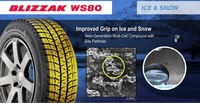Bridgestone Blizzak WS-80 Tire Test and Review: Great Tires For Winter Roads (Great on ice, slush and snow, too!)
By Thom Cannell
Senior Editor
Michigan Bureau
The Auto Channel
The Auto Channel tests Bridgestone's newest winter tire, the WS-80 and talks about the tire with Kurt Berger from Bridgestone’s sales engineering department .
Several years ago we commented on, and tested, Bridgestone’s WS-70, replaced by the even better WS-80. What stands out from this test, and those of other tires designed for snow, ice, slush, and extreme cold weather is that we need to stop thinking of these seasonal tires as snow tires. They are Winter tires. The difference between winter tires and others is in the design and execution of a tire meant for the coldest months of the year. Winter tires, regardless the presence of snow or ice, deliver better pavement grip in winter weather. These are tires with the 3 Peak Mountain emblem or M+S LT designation.
We have a set of Bridgestone WS-80s mounted on a staffer’s car that went through the worst Michigan sent us, ice and snow and rain with never a slip. In January we recommended the WS-80 to a friend with a new Infiniti who said, “They are fantastic! The traction is simply unbelievable.” We had a similar reaction.
Your first vital fact, and reason to have a second set of wheels and tires (buy inexpensive wheels, not matching $800/per alloy’s) is that even the best “all season” tires stiffen in the cold. New generation winter tires use special polymers to keep the tires flexible in cold weather. Bridgestone calls their new compound Nanopro-Tech with RC polymer. In the mixture of complex polymers (rubber mixed with artificial rubber and other long-chain molecules) is silica to maintain flexibility. This chemistry is proprietary knowledge and deep science.
 |
TACH: How has Bridgestone improved elasticity of the tire while resisting wear?
Kurt:With winter tires, a problem—one of six we try to solve with winter tires—is maintaining plasticity as the temperature drops. Since the origin of Blizzak in the early 90s, maintaining pliability has been front and center. From a compound standpoint, we’re achieving those physical characteristics of being basically insensitive to temperature variation. We've made great strides in that area with Nanopro-Tech an ability we've developed at a molecular level to manage a wide range of performance characteristics and physical characteristics, This impacts heat build up, rolling resistance, and can impact tread wear.
There's an additional component beyond Nanopro-Tech, Multi-Cell. Multi-Cell applies to porosity, there are actually microscopic pores in the compound. That lends itself to increasing snow traction. It can also make the compound more pliable..
 |
Kurt: Some attributes of the Blizzak W-80 tire that will enhance tire wear characteristics are not compounds. With these very soft, very pliable compounds you get more movement in the tread area; the blocks tend to move around as you rotate through the contact patch. We want to maintain that pliability and we want the blocks themselves to be stiffer. Enhanced stiffness not only improves handling on a dry road, it improves wear. The more those blocks are moving around, squirming, that creates friction and friction creates wear. So the 3-D siping actually creates a more rigid tread block to counteract the increased pliability of the actual compound.
TACH:You brought up siping, do you still cut tires with rotating knives?
Kurt: Sipes are molded in. When we get into 3-D siping technology the challenge is, if you can imagine the tires being pressed at a very high temperature into a mold and having that rubber flow, not just through a straight-cut sipe, but having it turn and twist several times, that is a challenge.
TACH: Also on our question list are the Multi-Cell and hydrophilic attributes you’ve mentioned.
Kurt:A traditional tire repels water. We have agents to expedite release of new tires from the mold, and those compounds repel water and repelling water is the last thing we want to do with Blizzak technology. We have moved towards chemicals that have physical properties that will create hydrophilic or water-loving behaviors, like a car with no wax finish during a rain storm.
With those Multi-Cells, the goal is to literally mop up the water between tire and snow or ice. You literally have a part of that (microscopic water trap) that was still filled with air because the water would not enter. Multi-Cell changes how water reacts to the (tire) surface and water is mopped up by these pores.
TACH: Are you able to create a Multi-Cell tread that will last the whole tire?
Kurt: The Multi-Cell compound will last through roughly 55% of the tire, then the compound beneath is a conventional winter tire. The Bridgestone Blizzak WS-80 remains a winter tire throughout its service life.
TACH: Anything else to say about the old tire versus new?
Kurt: I don't believe we talked about zig-zag siping. The 3D siping is something beneath the surface. You will notice the zig-zag on the WS-80, a wave. What we're attempting to do is to increase the grip or wear edge of the tire specifically for snow traction. Not ice. We've gotten roughly 20% increase in the amount of block edge exposure as compared to the WS-70. So we're looking for biting edges for snow performance.
 |
TACH: After living with the Blizzak WS-80 and it’s predecessor, we are convinced that having winter tires is a necessity for keeping your family—like ours—safe. The expense of winter tires is more than offset by even the inconvenience of even the smallest accident. Plus, there’s the $500 or more insurance deductible, later the higher rates that linger for years. However, family and personal safety is priceless.
SEE ALSO: How to Make a Honda CR-V Even Better - Bridgestone Blizzak



